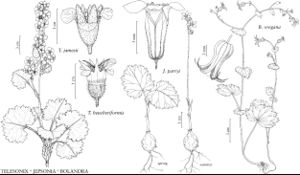Difference between revisions of "Bolandra"
Proc. Amer. Acad. Arts 7: 341. 1868 ,.
imported>Volume Importer |
imported>Volume Importer |
||
| Line 56: | Line 56: | ||
|publication year= | |publication year= | ||
|special status= | |special status= | ||
| − | |source xml=https:// | + | |source xml=https://bitbucket.org/aafc-mbb/fna-data-curation/src/2e0870ddd59836b60bcf96646a41e87ea5a5943a/coarse_grained_fna_xml/V8/V8_238.xml |
|genus=Bolandra | |genus=Bolandra | ||
}}<!-- | }}<!-- | ||
-->[[Category:Treatment]][[Category:Saxifragaceae]] | -->[[Category:Treatment]][[Category:Saxifragaceae]] | ||
Latest revision as of 22:42, 5 November 2020
Herbs, not rhizomatous or stoloniferous; caudex erect, slender, bearing bulbils at base. Flowering stems erect to ascending, leafy, 10–40 cm, stipitate-glandular. Leaves in basal rosette and cauline; cauline leaves conspicuous, reduced and bractlike distally; stipules present; petiole glabrous; blade reniform to orbiculate, 5–13-lobed, base cordate, ultimate margins irregularly serrate to crenate-dentate, apex obtuse to acute, surfaces glabrous; venation palmate. Inflorescences compound, dichasial cymes, terminal from terminal bud in basal rosette, 5–18-flowered, bracteate. Flowers: hypanthium free from ovary, greenish to purple; sepals 5, greenish to purple, (narrowly triangular to triangular-ovate); petals 5, greenish with purple margins or reddish purple to dark purple; nectary tissue not seen; stamens 5; filaments filiform; ovary nearly superior, 2-locular, ovaries connate 1/4–1/2 their lengths; placentation axile; styles 2; stigmas 2. Capsules 2-beaked. Seeds dark brown, prismatic (or angular) and fusiform, minutely tuberculate. x = 7.
Distribution
w United States.
Discussion
Species 2 (2 in the flora).
Both the monograph by R. J. Gornall and B. A. Bohm (1985) and the molecular systematic work of D. E. Soltis et al. (1993) support a close relationship among Bolandra, Boykinia, and Suksdorfia. Other genera that appear to be closely related to these are Jepsonia, Sullivantia, and Telesonix (Soltis et al.).
Selected References
None.
Lower Taxa
Key
| 1 | Leaf blades deeply lobed, ultimate margins crenate-dentate; ovaries connate proximally 1/2 their lengths; petals usually greenish with purple margins, 4-5(-7) mm. | Bolandra californica |
| 1 | Leaf blades shallowly lobed, ultimate margins serrate; ovaries connate proximally 1/4 their lengths; petals usually reddish purple to dark purple, 7-12(-14) mm. | Bolandra oregana |
